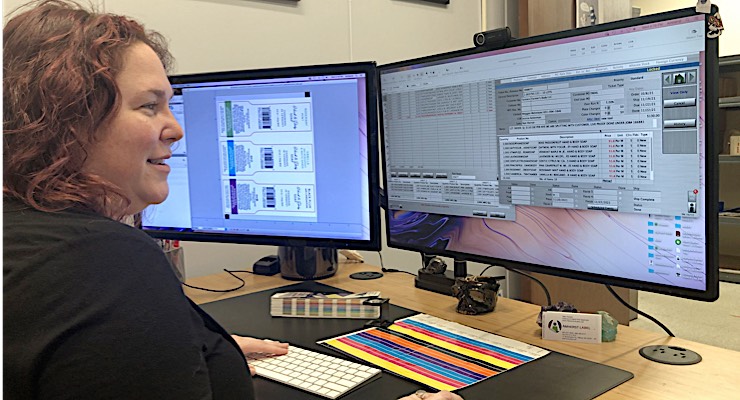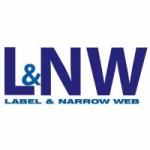Integrating systems
HYBRID Software and Label Traxx suggested that integrating their systems would be helpful for the Milford, NH-based converter.
Streamlining a business can be complex when you have islands of data stored in different software solutions. Data should be in one source and used throughout. Connecting and sharing data between MIS and production systems can gain efficiencies and improve quality for any label printer.
A single, company-wide software solution that consolidates the information from all departments, integrated with the MIS, will optimize production management – and offer more information for informed business decisions – accounting, estimating and more. CSRs can respond in real time to customer queries, and jobs are visible across all business departments. Prepress tasks can be completely driven by job ticket information located from an MIS/ERP. This is particularly helpful with fast-paced, short-run digital jobs. It also eliminates redundancy, like scheduling jobs or creating quotations manually, or creating handwritten job tickets. It also assures consistency in the way companies work internally and with customers.
Milford, NH-based Amherst Label, one of the most respected custom label printers in the Northeast, has helped customers create custom labels, tags, and decals on-time, on-budget and to specifications for over 40 years. The family-owned business continues to put its extensive custom label printing experience to work for customers. The company specializes in digital, flexographic, and screen printing for a wide variety of industries, including bottle/beverage, direct mail, flexible packaging, healthcare, industrial, nutraceutical, and specialty foods.
Amherst installed Label Traxx MIS software in 2013 to replace a system that wasn’t built by people knowledgeable about labels. Meanwhile, in the prepress department, graphic artists did everything manually, utilizing apps like Adobe Illustrator and Photoshop for tasks like step and repeat. Katie Putnam, prepress/digital print supervisor, recalls, “With 10 sales reps/CSRs, our three graphic artists were getting buried every day.” They installed HYBRID PACKZ and HYBRID CLOUDFLOW to streamline tasks.
HYBRID Software and Label Traxx suggested that integrating their systems would be helpful. “We talked with another label company who had done the same thing and reported how well it improved their ability to process orders,” says Jim Cutler, operations manager.
When integrating MIS and production systems together, there are considerations. “We needed help from Label Traxx and HYBRID Software because we don’t have an on-site IT staff. Another issue is setting up the servers with the right file paths. You have to ensure you have solid help who understands what you’re doing,” suggests Cutler.
“It was great to have help onsite to see what we could do on a day-to-day basis—and contemplate how to automate the process,” adds Putnam.
Cutler also recommends anyone to understand what their customer service department will have to do in advance, because the process will change. “Our biggest challenge has been helping CSRs become comfortable with the new process.”
Replacing manual tasks with automation
Since the integration began in 2019, Amherst Label has saved considerable time because it has eliminated many manual tasks. For example, before they took all order information from Label Traxx and wrote it on a piece of paper that was passed to prepress. Then, prepress would retype that data into a proof slug. “Obviously there was a lot of room for transposing numbers incorrectly or forgetting to change something,” says Putnam. “Now, we just import the metadata. That not only saved time but also eliminated errors.”
Working during COVID, Amherst Label tried to limit the walking its people did around it building. Eliminating the paper workflow really helped.
The greatest opportunity for accurate repeatability was step and repeat for their fast-paced digital work. Automating proofing, and different across step and repeat files, have saved a lot of time. “Manually, sometimes you don’t grab a small piece somewhere, and lose it. You’ll have it on the original, but miss it on all the repeats. Now, we create our label repeat file plan in Label Traxx and perform it automatically in HYBRID PACKZ. They’re always correct,” comments Putnam. “It’s very helpful for jobs that hold a large number of lots on the actual ticket. With 50 lots, we hit a button and automate the different ‘across files’ in two or three minutes – versus 10 minutes to create each file manually.”
Over the past couple years, Amherst Label has grown exponentially. Putnam has taken on digital management responsibilities in addition to prepress. “So instead of operating with three dedicated people, we’ve cut back to two and a half, and they’re still handling the increased workload,” marvels Cutler. “With the integration of our MIS and production systems, our customer satisfaction rate has been 99%, which means there was only 1% rejected work – with the same staff.”
“In the future, we’ll be utilizing information that flows back to Label Traxx, so CSRs can review job status without walking on the print floor,” says Putnam. “We’d also like to feed die line drawings back into Label Traxx and populate them into the die tooling information. The CSRs have seen bits and pieces of automation, and they’re pretty excited.”
Amherst Label links this entire innovative system to its pledge to a three-year visioning process called its Painted Picture. That commitment to improvement, progress, and being the very best they can be is often the driver for these kinds of investments.
Visit the Amherst website here.

